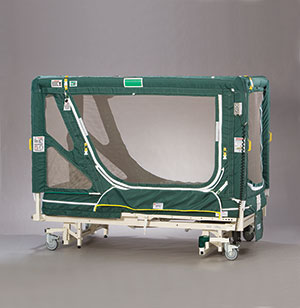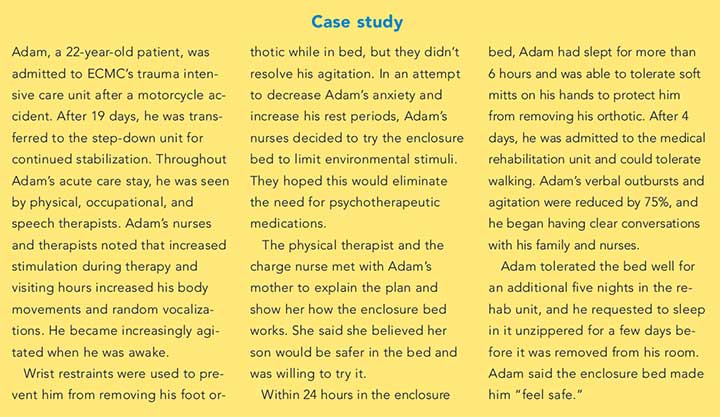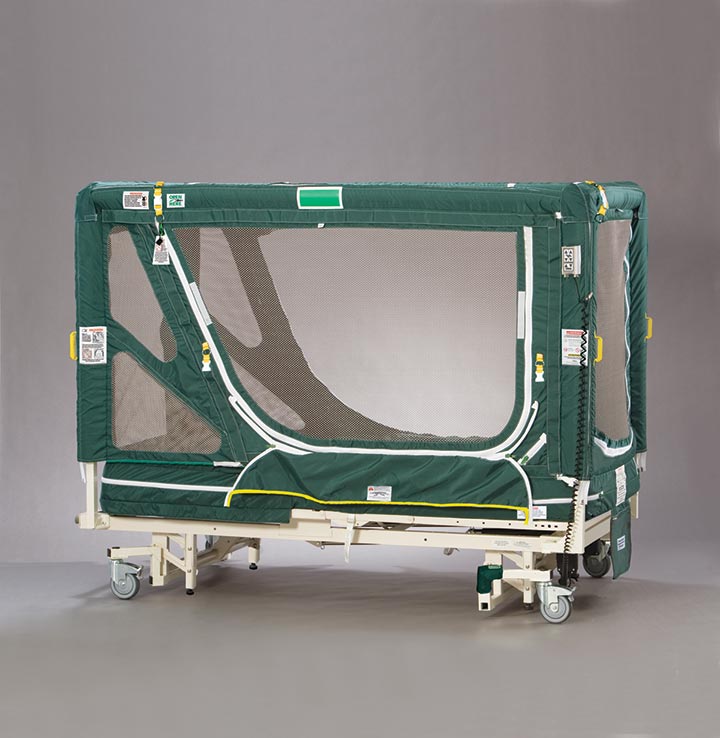By Dawn Walters, MS, RN, Vice-President of Behavioral Health and Rehabilitation Services Erie County Medical Center, Buffalo, New York As told to Janet Boivin, BSN, RN
At Erie County Medical Center, we’ve found enclosure beds to be an effective means to decrease stimulation for highly agitated patients with traumatic brain injury (TBI) who may injure themselves. The beds help calm patients with TBI or those who are cognitively impaired.
 Case-by-case use
Case-by-case use
ECMC has eight enclosure beds* that can be used in most units of the hospital as necessary. Use is determined on a case-by-case basis and hinges on patient behavior, such as agitation. Patients with urinary catheters are eligible for the bed, but not those with other kinds of tubing such as I.V. catheters.
Enclosure beds are ordered by the provider for 24-hour periods. Each order must be accompanied by a reason for the bed’s use, and a new order must be placed at the end of each 24-hour period.
Most patients who require an enclosure bed are receiving therapy services, which helps determine cognitive levels and aids in teaching patients and families about what to expect during recovery.
Patients and family members are educated about why the staff is recommending an enclosure bed and how it’s used. In many cases, families are more wary about using the bed than patients. Families need reassurance about why the enclosure bed is necessary and how it will benefit their loved one. Nurses demonstrate how the bed works, how to lock and unlock the zippers, and how to make sure the patient is safe. We emphasize that the patient will be closely watched.
Close monitoring
Patients in enclosure beds need to be monitored closely. We release patients from the bed and assess them every 30 minutes. (Know that monitoring requirements vary by state, so it’s important to be in compliance with state and Centers for Medicare & Medicaid Services requirements.)
Patients aren’t restricted to the bed at all times. They’re always offered fluids, if allowed, and toileting opportunities.
We assess skin condition and make sure patients are appropriately managed, and we do our normal hourly rounding on the units. We document all of our interventions, and those who ordered the bed have to document the need for its continued use.
As the patient recovers, becomes less agitated and restless, and demonstrates reduced need for the enclosure bed, we transfer him or her to a regular hospital bed.
Use them for the right reasons
Using enclosure beds for the right reasons and being thoughtful about how they’re implemented is important. They can be beneficial for certain patients by helping them stay calm and be less agitated, which promotes recovery and a return to their previous state of health whenever possible.

Editor’s note: This is one in a series of case studies describing success stories in preventing falls and injuries from falls. The series is brought to you by TIDI.
